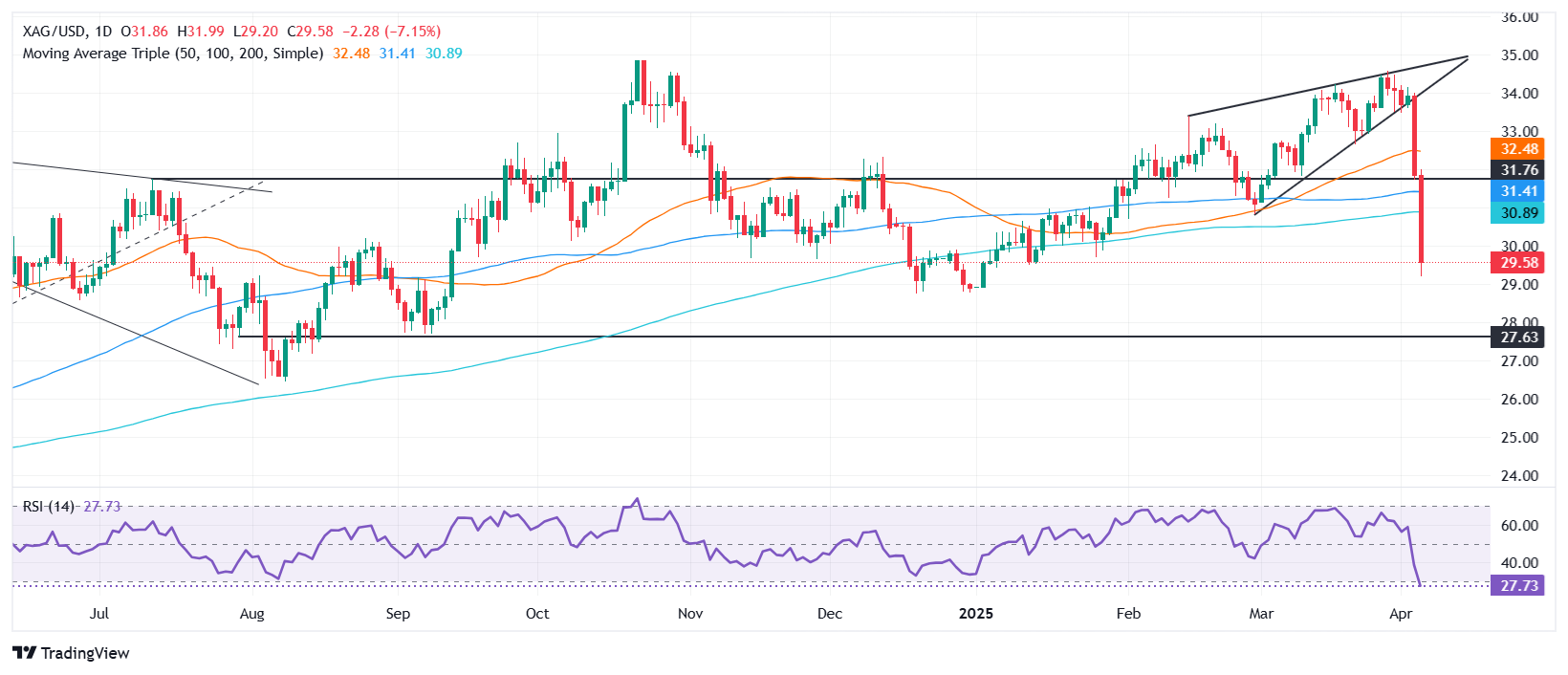Silver Price Forecast: XAG/USD collapses over 7%, drops below $30.00
- Silver breaks below 100- and 200-day SMAs, signals strong bearish momentum amid escalating US-China tariff battle.
- RSI enters oversold territory, but selling pressure may continue toward $28.74 and $27.71 if $29 fails to hold.
- A recovery above $30 could see buyers retest $30.86 SMA and key resistance near $31.00.
Silver price plummeted on Friday as financial market turmoil continued for the third straight day, following US President Donald Trump's decision to impose reciprocal tariffs. Consequently, China retaliated, sparking fears of a global economic slowdown. The XAG/USD trades at $29.55, sinking more than 7%.
XAG/USD Price Forecast: Technical outlook
On its way lower, Silver fell below the 100- and 200-day Simple Moving Averages (SMAs) on Friday, indicating a strong sell-off, once the grey metal cleared $31.39 and $30.86, respectively. Although the Relative Strength Index (RSI) turned bearish and oversold, due to the aggressiveness of the move, XAG/USD could continue to edge lower.
If XAG/USD falls below $29.00, this could expose the December 19 swing low of $28.74. Once surpassed, the next support would be the September 3 low of $27.71. Conversely, if XAG/USD climbs past $30.00, buyers could be poised to challenge the 200-day SMA at $30.86, followed by the $31 mark.
XAG/USD Price Chart – Daily

Silver FAQs
Silver is a precious metal highly traded among investors. It has been historically used as a store of value and a medium of exchange. Although less popular than Gold, traders may turn to Silver to diversify their investment portfolio, for its intrinsic value or as a potential hedge during high-inflation periods. Investors can buy physical Silver, in coins or in bars, or trade it through vehicles such as Exchange Traded Funds, which track its price on international markets.
Silver prices can move due to a wide range of factors. Geopolitical instability or fears of a deep recession can make Silver price escalate due to its safe-haven status, although to a lesser extent than Gold's. As a yieldless asset, Silver tends to rise with lower interest rates. Its moves also depend on how the US Dollar (USD) behaves as the asset is priced in dollars (XAG/USD). A strong Dollar tends to keep the price of Silver at bay, whereas a weaker Dollar is likely to propel prices up. Other factors such as investment demand, mining supply – Silver is much more abundant than Gold – and recycling rates can also affect prices.
Silver is widely used in industry, particularly in sectors such as electronics or solar energy, as it has one of the highest electric conductivity of all metals – more than Copper and Gold. A surge in demand can increase prices, while a decline tends to lower them. Dynamics in the US, Chinese and Indian economies can also contribute to price swings: for the US and particularly China, their big industrial sectors use Silver in various processes; in India, consumers’ demand for the precious metal for jewellery also plays a key role in setting prices.
Silver prices tend to follow Gold's moves. When Gold prices rise, Silver typically follows suit, as their status as safe-haven assets is similar. The Gold/Silver ratio, which shows the number of ounces of Silver needed to equal the value of one ounce of Gold, may help to determine the relative valuation between both metals. Some investors may consider a high ratio as an indicator that Silver is undervalued, or Gold is overvalued. On the contrary, a low ratio might suggest that Gold is undervalued relative to Silver.
